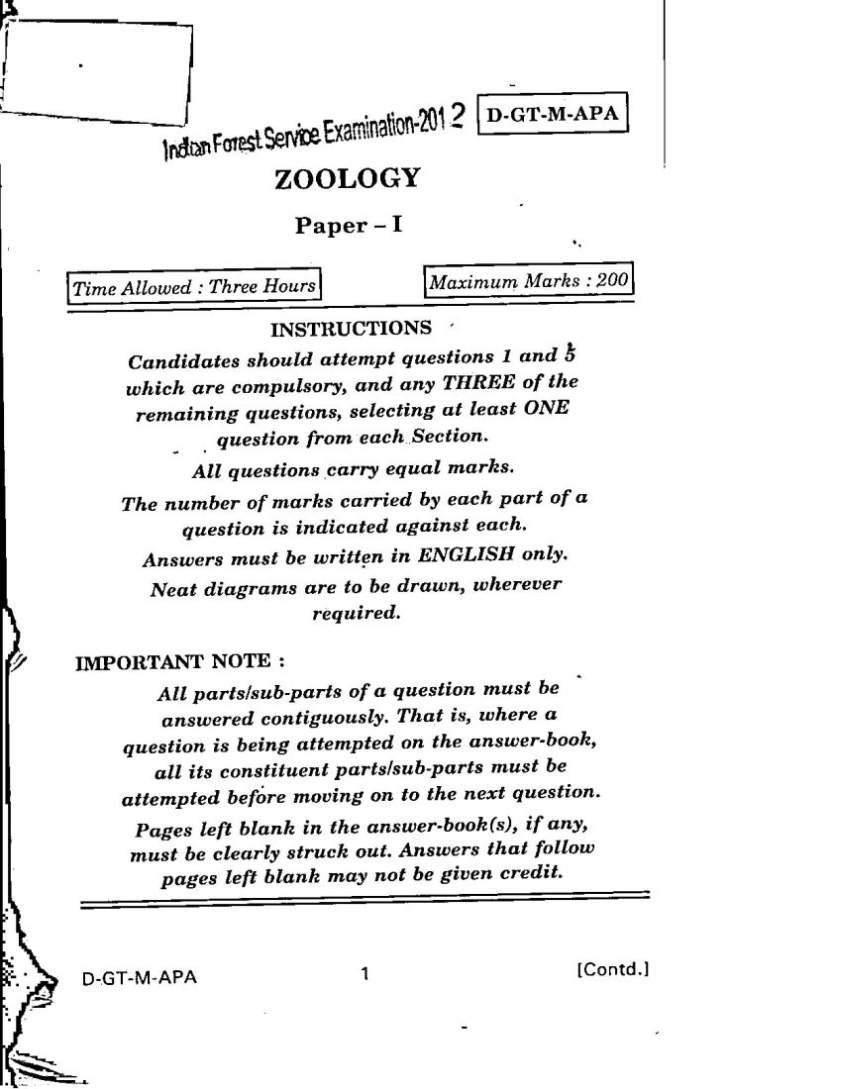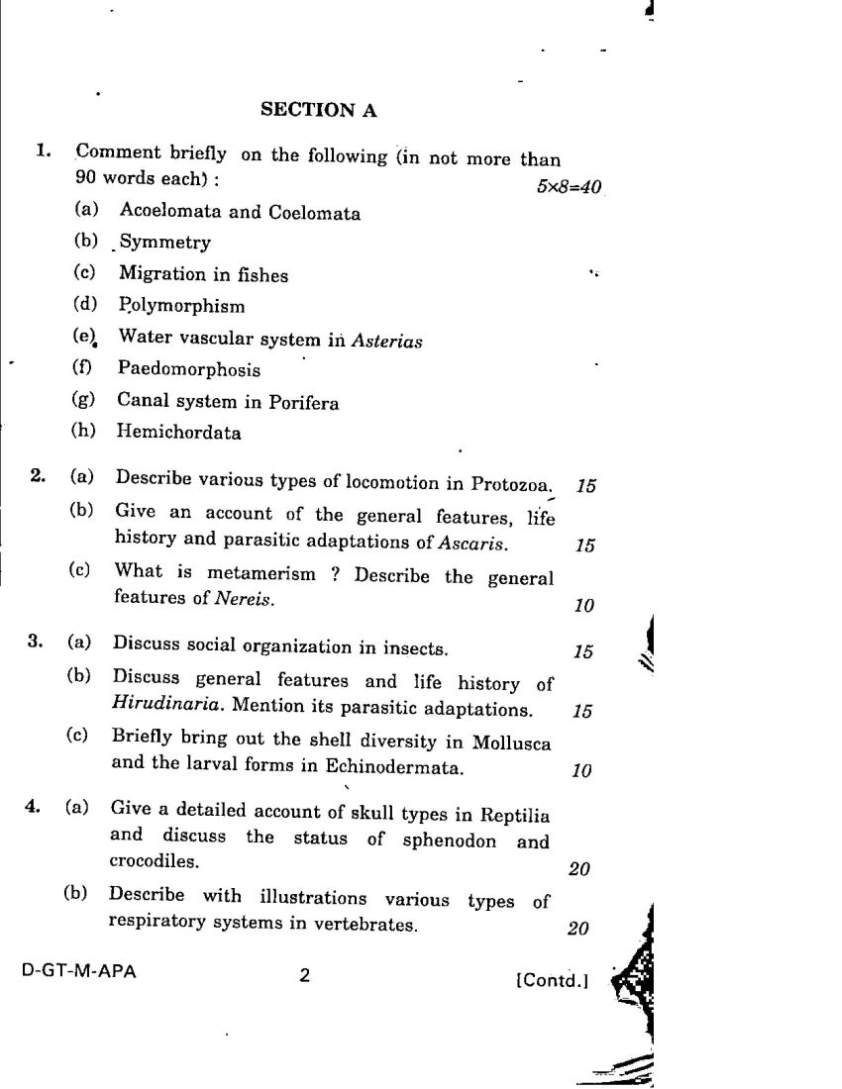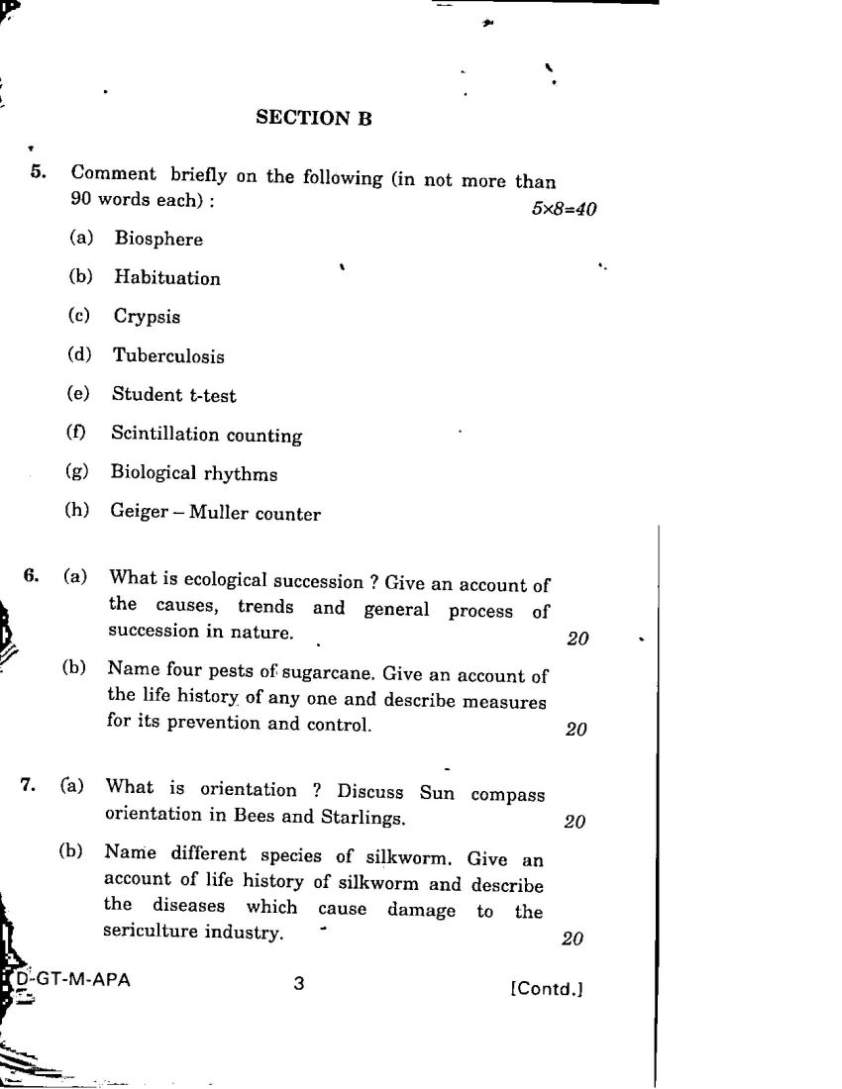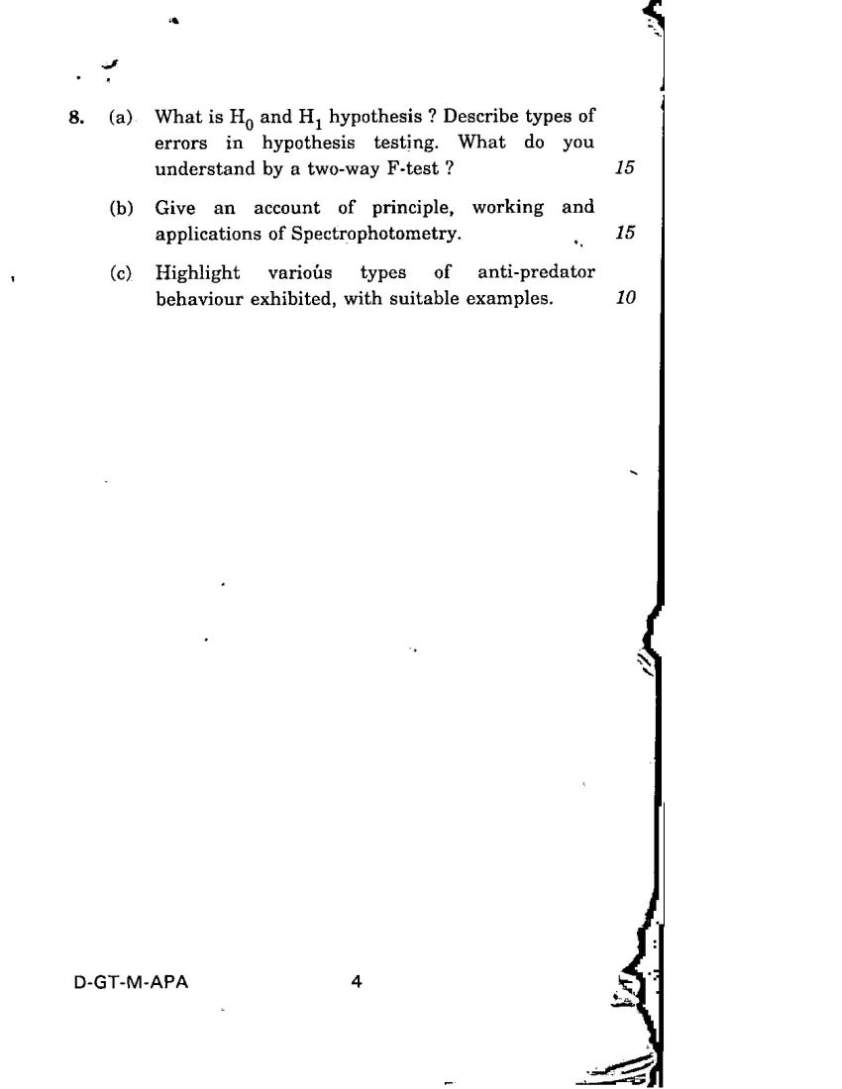|
#2
9th August 2014, 11:43 AM
| |||
| |||
| Re: Indian Forest Service Zoology previous year question papers
As you want to get the Indian Forest Service Zoology previous year question papers so here it is for you: Here for your reference I am giving you the syllabus of Indian Forest Service Zoology: Paper-I Section A 1. Non-chordata and chordata: a. Classfication and relationship of varous phyla upto sub-classes; Acoelomata and Coelomata; Protostomes and Deuterostomes, Bilateralia and Radiata; Status of Protista, Parazoa, Onychophora and Hemichordata; Symmetry. b. Protozoa: Locomotion, nutrition, reproduction; evolution of sex; General features and life history of Paramaecium, Monocystis, Plasmodium, and Leishmania. c. Porifera: Skeleton, canal system and reproduction. d. Coelenterata: Polymorphism, defensive structures and their mechanism; coral reefs and their formation; metagenesis; general features and life history of Obelia and Aurelia. e. Platyhelminthes: Parasitic adaptation; general features and life history of Fasciola and Taenia and their relation to man. f. Nemathelminthes: General features, life history and parasitic adaptation of Ascaris; nemathelminths in relation to man. g. Annelida: Coelom and metamerism; modes of life in polychaetes; general features and life history of nereis (Neanthes), earthworm (Pheretima) and leach (Hirudinaria). h. Arthropoda: Larval forms and parasitism in Crustacea; vision and respiration in arthropods (prawn, cockroach and scorpion); modification of mouth parts in insects (cockroach, mosquito, housefly, honey bee and butterfly); metamorphosis in insects and its hormonal regulation; social organization in insects (termites and honey bees). i. Mollusca: Feeding, respiration, locomotion, shell diversiy; general features and life history of Lamellidens, Pila and Sepia, torsion and detorsion in gastropods. j. Echinodermata: Feeding, respiration, locomotion larval forms; general features and life history of Asterias. k. Protochordata: Origin of chordates; general features and life history of Branchiostoma and Herdamania. l. Pisces: Scales, respiration, locomotion, migration. m. Amphibia: Origin of tetrapods; parental care, paedomorphosis. n. Reptilia: Origin of reptiles; skull types; status of Sphenodon and crocidiles. o. Aves: Origin of birds; flight adaptation, migration. p. Mammalia: Origin of mammals; denitition; general features of egg-laying mammals, pouched-mammals, aquatic mammals and primates; endocrine glands and other hormone producing structures (pituitary, thyroid, parathyroid, adrenal, pancreas, gonads) and their interrelationships. 2. Comparative functional anatomy of various systems of vertebrates (integument and its derivatives, endoskeleton, locomotory organs, digestive system, respiratory system, circulatory system including heart and aortic arches; urino-genital system, brain and sense organs (eye and ear). Paper-I Section B 1. Ecology: 1.1. Biospher: Biogeochemical cycles, green-houses effect, ozone layer and its impact; ecological succession, biomes and ecotones. 1.2. Population, characteristics, population dynamics, population stabilization. 1.3. Conservation of natural resources- mineral mining, fisheries, aquaculture; forestry; grassland; wildlife (Project Tiger); susainable production in agriculture-integrated pest management. 1.4. Environmental biodegradation; pollution and its impact on biosphere and its prevention. 2. Ethology: 2.1. Behaviour : Sensory filtering, responsiveness, sign stimuli, learning, instinct, habituation, conditioning, imprinting. 2.2. Role of hormones in drive; role of pheromones in alarm spreading; crypsis, predator detection, predator tactics, social behaviour in insects and primates; courtship (Drosophila, 3-spine stickleback and birds). 2.3. Orientation, navigation, homing; biological rhythms; biological clock, tidal, seasonal and circadian rhythms. 2.4. Methods of studying animal behaviour. 3. 3. Economic Zoology: 3.1. Apiculture, sericulture, lac culture, carp culture, pearl culture, prawn culture. 3.2. Major infectious and communicable diseases (small pox, plague, malaria, tuberculosis, cholera and AIDS) their vectors, pathogens and prevention. 3.3. Cattle and livestock diseases, their pathogens (helminths) and vectors (ticks, mites,Tabanus, Stomoxys) 3.4. Pests of sugar cane (Pyrilla perpusiella), oil seed (Achaea janata) and rice (Sitophilus oryzae). 4. Biostatistics: Designing of experiments; null hypothesis; correlation, regression, distribution and measure of central tendency, chi square, student t-test, F-test (one-way & two-way F-test) 5. Instrumental methods: 5.1. Spectrophotometry, flame photometry, Geiger-Muller counter, scintiliation counting. 5.2. Electron microscopy (TEM, SEM). Paper-II Section-A 1. Cell Biology: 1.1. Structure and function of cell andits organelles(nucleus, plasma membrane, mitochondria, Golgi bodies, endoplasmic reticulum, ribosomes and Iysosomes), cell division (mitosis and meiosis), mitotic spindle and mitotic apparatus, chromosome movement. 1.2. Watson-Crick model of DNA, replication of DNA, protein synthesis, transcription and transcription factors. 2. Genetics: 2.1. Gene structure and functions; genetic code. 2.2. Sex chromosomes and sex determination in Drosophilla, nematodes and man. 2.3. Mendel's laws of inheritance, recombination, linkage, linkage-maps, multiple alleles, cistron concept; genetics of blood groups.2.4. Mutations and mutagenesis : radiation and chemical. 2.5. Cloning technology, plasmids and cosmids as vectors, transgenics, transposons, DNA sequence cloning and whole animal cloning (Principles and methodology). 2.6. Regulation and gene expression in pro-and eu-karyotes. 2.7. Signal transduction; pedigree-analysis; congenital diseases in man. 2.8. Human genome mapping; DNA finger-printing. 3. Evolution: 3.1. Origin of life 3.2. Natural selection, role of mutation in evolution, mimicry, variation, isolation, speciation. 3.3. Fossils and fossilization; evolution of horse, elephant and man. 3.4. Hardy-Weinberg Law, causes of change in gene frequency. 3.5. Continental drift and distribution of animals. 4. Systematics: Zoological nomenclature; international code; cladistics. Paper-II Section B 1. 1. Biochemistry: 1.1. Structure and role of carbohydrates, fats, lipids, proteins, aminoacids, nucleic acids; saturated and unsaturated fattyacids, cholesterol. 1.2. Glycolysis and Krebs cycle, oxidation and reduction, oxidative phosphorylation; energy conservation and release, ATP, cyclic AMP-its structure and role. 1.3. Hormone classification (steroid and peptide hormones), biosynthesis and function. 1.4. Enzymes : types and mechanisms of action; immunoglobulin and immunity; vitamins and co-enzymes. 1.5. Bioenergetics. 2. Physiology (with special refernece ot mammals): 2.1. Composition and constituents of blood; blood groups and Rh factor in man; coagulation, factors and mechanism of coagulation; acid-base balance, thermo regulation. 2.2. Oxygen and carbon dioxide transport; haemoglobin: constituents and role in regulation. 2.3. Nutritive requirements; role of salivary glands, liver, pancreas and intestinal glands in digestion and absorption. 2.4. Excretory products; nephron and regulation of urine formation; osmoregulation. 2.5. Types of muscles, mechanism of contraction of skeletal muscles. 2.6. Neuron, nerve impulse-its conduction and synaptic transmission; neurotransmitters. (g) Vision, hearing and olfaction in man. 2.7. Mechanism of hormone action. 2.8. Physiology of reproduction, role of hormones and phermones. 3. Developmental Biology: 3.1. Differentiation from gamete to neurula stage; dedifferentiation; metaplasia, induction, morphogenesis and morphogen; fate maps of gastrulae in frog and chick; organogenesis of eye and heart, placenation in mammals. 3.2. Role of cytoplasm in and genetic control of development; cell lineage; causation of metamorphosis in frog and insects; paedogenesia and neoteny; growth, degrowth and cell death; ageing; blastogenesis; regeneration; teratogenesis; neoplasia. 3.3. Invasiveness of placenta; in vitro fertilization; embryo transfer, cloning. 3.4. Baer's law: evo-devo concept. Indian Forest Service Botany previous year question papers     Contact Details: Union Public Service Commission UPSC, Man Singh Road Area, New Delhi, Delhi 110069 India Map Location: [MAP]https://www.google.co.in/maps?q=`+Public+Service+Commision,+UPSC,+Man+Singh +Road+Area,+New+Delhi,+Delhi&hl=en&ll=28.608656,77 .227728&spn=0.009513,0.013046&sll=23.814107,86.441 138&sspn=0.009914,0.013046&oq=`+Pu&t=m&z=16&iwloc= A[/MAP] |
